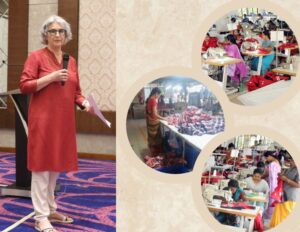The Operationalising Labour Rights (OLR), is a project led by a research team at Cardiff University, UK, in collaboration with Cividep India. Jean Jenkins, Rhys Davies and Helen Blakely have worked with Cividep’s Rekha Chakravarthi and Kaveri Thimmaiya, on a project that aims to reveal the social relations of the garment factory. “The findings are paramount in illuminating the nature of power relations in the (garment) industry,” said Indrani Mazumdar, writer and scholar, about the draft report presented at a recent workshop. The aim of the OLR project is to understand how and whether garment workers have access to remedy at their workplaces. In this interview, Professor Jenkins talks about why she and her colleagues decided to study grievances as a means to gaining insight into factories that have remained inaccessible to independent researchers, how the findings have already been incorporated into a UN project, and how other researchers could use the same methodology to create worker-centric research.
Jean, you were not always an academic and began your working life outside University. At one time you were an HR manager for garment factories in the UK. How did you go from this to being an academician researching the same industry?
In the late 1980s, I was working as Divisional Personnel Manager (HR manager) for a Division of one of the UK’s largest clothing manufacturers of the day – Courtaulds Clothing. That’s where I learnt about work study, production engineering, and the workings of a factory floor.
I had joined the industry at a time when the industry was shifting from the UK to locations like Hong Kong, Korea and Morocco. The whole process was traumatic for workers – and for shop-floor managers as well. The factories I worked in back then were highly unionised, had collective bargaining and reasonably good working conditions, all of which were being undermined. For a range of associated reasons, I decided to leave the industry to return to education and study industrial relations. I wanted to learn more about the things I was experiencing in my work. It was a challenging journey, but coming into academia later in life made it all the more important to me that I should conduct research and writing with a sense of purpose.
Why did you decide to study the garment workers in Bangalore through the OLR project, in association with Cividep India? Apart from Covid-19 related complications, what other challenges did you face?
By the early 2000s I knew that studying the garment industry would mean following the supply chain to its new locations. I didn’t have any contacts outside the UK at that time. It was my good fortune to connect with Cividep. That’s where my studies in India started.
It was some years later that the OLR project took shape. Studying grievances allows us to get a glimpse of what is actually happening inside the factories without physically entering the premises or putting anyone at risk. We designed OLR in such a way that it is worker-driven, as workers provide the information. As researchers, our role is to ensure it is rigorously recorded and analysed.
The OLR project started in 2018. Grievances reported to GLU (Garment Labour Union) were collated using a tablet survey tool developed by Helen Blakely, Rhys Davies and Catriona Dickson at Cardiff.
The Cividep team, comprising Rekha (Director – Business & Human Rights) and Kaveri (Research Associate), spent a substantial amount of time and dedicated effort in translating the data for analysis.
What is the most remarkable finding from the data, and how do you and your colleagues plan to present it?

Our database of grievances reveals how power is exercised in the workplace. In the detail of the grievances we see the profile of how violations take place and how a worker can easily be labelled a troublemaker for raising an issue. The conventional response to violations is to advocate for more regulations. However, examination of the grievances illustrates how rules and regulations are avoided, evaded and neutralised within workplaces. From an analytical perspective, the true value of analysis of grievances lies in the ability to glimpse the relationship between managers, supervisors, and workers. They tell us about how managers behave in practice, when they think nobody is looking.
How do you think the OLR findings and case studies will impact policies and public perception of the garment industry?
We already have some impact as our research has contributed to the third phase of the UN OHCHR Accountability and Remedy Project (ARP III). This is a project focused on realising the aims of the UN Guiding Principles on Human Rights.
The other potential contribution of the project might be through the sharing of the research methods we employed, which can be adapted to a range of different settings.
What has been the response of students and colleagues and other peers to the OLR research?
Our peers are particularly interested in the methodological approach we have taken. We also emphasise through our data analysis that we should not lose the humanity of the cases.
If there is a core legacy of this project, it might be to remind stakeholders that power has to be placed at the heart of any analysis of working conditions – and that here is a research method that can be used and adapted to allow us hear from workers themselves!
